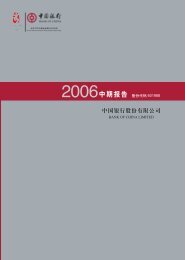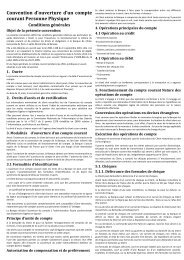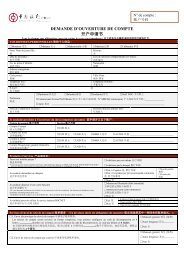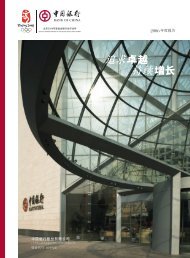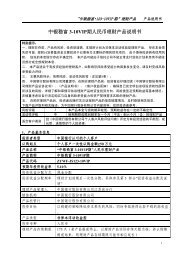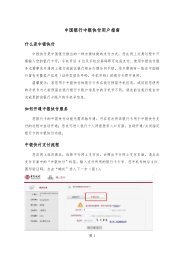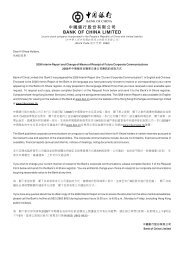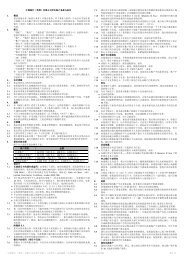2006 Interim Reportï¼A Share.pdf - ä¸å½é¶è¡
2006 Interim Reportï¼A Share.pdf - ä¸å½é¶è¡
2006 Interim Reportï¼A Share.pdf - ä¸å½é¶è¡
Create successful ePaper yourself
Turn your PDF publications into a flip-book with our unique Google optimized e-Paper software.
Management Discussion & Analysis<br />
30 June <strong>2006</strong> RMB (%) Foreign Currencies (%)<br />
Liquidity ratio 32.03 45.88<br />
Loan-deposit ratio of domestic operations 56.47 71.95<br />
Excess reserve ratio ★ 2.58 17.07<br />
★<br />
Deposit reserve refers to the deposits with the Central Bank for the purpose of ensuring the withdrawal of deposits and fund clearing by<br />
customers, and deposit reserve ratio is the proportion of deposit reserve required by the Central Bank in total balance of deposits.<br />
Deposit reserve and deposit reserve ratio are composed of two parts. The deposit reserve ratio stipulated by the Central Bank is called<br />
statutory deposit reserve ratio, which stands at 7.5% at present, i.e. commercial banks must deposit 7.5% of deposits received with the<br />
Central Bank; the corresponding deposits is called statutory deposit reserve. The reserve beyond statutory deposit reserve is called excess<br />
reserve, and the proportion of excess reserve in total deposits is the excess reserve ratio.<br />
The above liquidity ratio is calculated in accordance with the relevant provisions of the People's Bank of China and CBRC. and the<br />
financial data are based on the Accounting Standard for Business Enterprises and Accounting System for Financial Institutions.<br />
Internal Control and Operational Risk<br />
Internal Control The Bank is committed to continuously improve its internal control system by establishing three<br />
defense lines composed of function management, compliance control and internal audit. By clarifying the responsibilities<br />
of all business units, the Bank seeks to ensure effective risk prevention and optimum resource allocation from the<br />
management framework perspective.<br />
The principal objective of developing internal control function is to establish a compliance culture and construct a<br />
comprehensive, dynamic, proactive and verifiable internal control environment, which is based on a sound internal<br />
control infrastructure and rules and regulations, supported by advanced information technology, guided by an effective<br />
incentive and accountability system, provides checks and balance, and emphasizes refined process control.<br />
As required by the Guidelines on Internal Control of Commercial Banks promulgated by the People's Bank of China, the<br />
Bank continuously reinforced internal control measures and improved internal control mechanism and environment in<br />
different business and management lines, including corporate banking, treasury services, personal banking business,<br />
e-banking, bank card, and human resources. Meanwhile, it also established monitoring system to conduct key monitoring<br />
and periodic reporting of such indicators as rotation, function in an acting capacity, and business errors.<br />
Operational risk Operational risk refers to the risk of losses caused by substandard or problematic internal procedures,<br />
human or system errors or external events. In the first half of <strong>2006</strong>, the Bank cooperated with RBS in respect of<br />
the operational risk management framework. The two parties carried out a preliminary study of operational risk<br />
management framework based on the Bank's conditions. Work processes were developed covering operational risk and<br />
control review, key risk indicators, reporting of significant events, etc. Pilot project relating operational risk and control<br />
assessment and key risk indicators was also activated.<br />
Internal Audit<br />
In order to fully leverage the function of internal audit in our corporate governance structure, in the first half of<br />
<strong>2006</strong>, the Bank appointed an independent external consulting agency to conduct an overall evaluation of its internal<br />
controls by referring to international internal audit industry best practices. Based on the evaluation results and<br />
regulatory requirements, the Bank started improving the organizational structure of internal audits, management<br />
techniques, reporting lines and practical standards, and devoted great efforts to build a new vertical, independent and<br />
46



